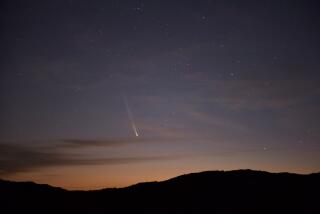Comet Search : Patience Pays Off as Amateur Combs the Stars
- Share via
The fourth comet discovered by amateur astronomer Don Machholz may disintegrate this month, but he says he won’t mind the disappearance of the dirty snowball he spotted with giant, homemade binoculars.
“It’s kind of a gift to find a comet. You’re grateful,” he said recently by telephone from his office in Santa Clara. “So if it’s taken away, that’s the way it goes.”
Comet Machholz 1988j “might sort of fizzle out” about the time it makes its closest approach to the sun on Sept. 17, said astronomer Brian Marsden, director of the International Astronomical Union’s Central Bureau for Astronomical Telegrams, which records astronomical discoveries.
“That happens with comets that are not terribly big to start with going only 15 million miles from the sun. It’s pretty hot there. It may disintegrate completely,” Marsden said by phone from Cambridge, Mass.
“It’s a very nice-looking comet, but it’s not getting brighter as it should,” Machholz said. “That’s some cause for concern about its existence,” because it suggests that the dust-laden snowball is too small to give off enough gas and dust to form a bright head.
It won’t be the first time a comet broke up after being discovered by Machholz, 35, of San Jose, who works at a company that makes medical lasers.
Machholz said his second discovery, comet Machholz 1985 VIII, disintegrated when it got to within about 11 million miles of the sun. He discovered comet 1988j on Aug. 6, and also was the first to spot comets Machholz 1978 XIII and Machholz 1986 VIII.
During a typical year, about six comets are discovered and six known comets are “recovered,” or spotted during their latest orbits through the inner solar system, Marsden said. The j in the comet’s name means it is the 10th either discovered or recovered in the solar system in 1988. Last year, a record 16 comets were discovered and 17 recovered.
Late last month, comet Machholz 1988j was about 80 million miles from the sun, Machholz said.
“It is a couple hundred times fainter than the North Star,” Marsden said. “It’s not going to be a bright comet,” and it is likely to be seen only by advanced amateur astronomers using telescopes.
More comets have been discovered by other astronomers, but Machholz holds the record for U.S. amateur astronomers who are still alive, Marsden said.
To Machholz’s chagrin, he is better known for spending 1,700 hours searching before discovering his first comet. His second comet took 1,742 hours to find.
Machholz made his latest discovery after 475 hours of observation from his customary viewing spot, along a dirt road 3,300 feet up Loma Prieta, a peak in the Santa Cruz Mountains south of San Francisco Bay.
He spotted it the same way as his 1986 discovery: using a pair of homemade binoculars weighing about 150 pounds. He built the binoculars for $400, using 10 aerial photo lenses, each 5 inches in diameter. He found his first two comets with a 10-inch reflector telescope.
“I enjoy comet-hunting,” Machholz said. “It’s a challenge.”
More to Read
Sign up for Essential California
The most important California stories and recommendations in your inbox every morning.
You may occasionally receive promotional content from the Los Angeles Times.













